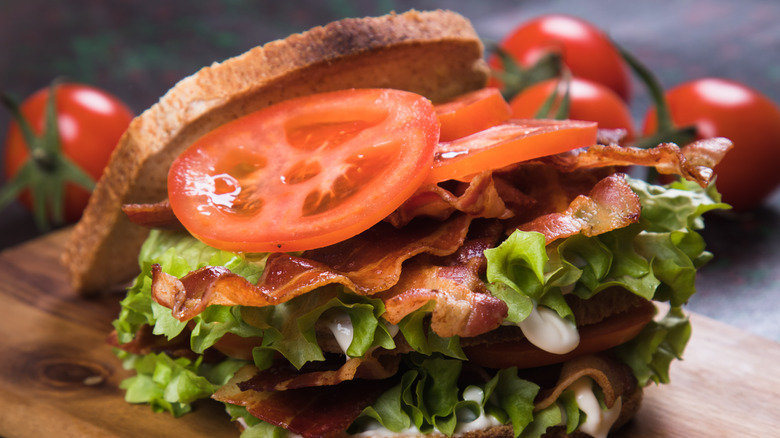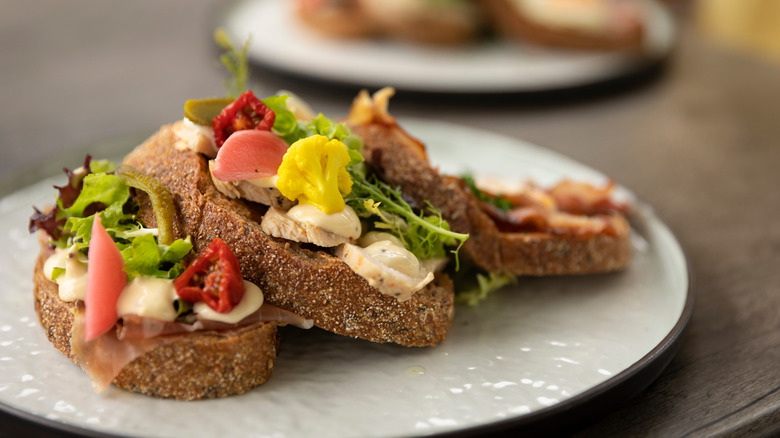The Mysterious Origins Of The BLT
Nearly 200 sandwiches are consumed per person each year in the U.S., according to PBS' The History Kitchen. And one of the most popular may be the classic BLT — consisting of crispy bacon, crunchy lettuce, and succulent tomato slices, coated with mayonnaise and served on toasted bread. At one time, according to Kiddle, the BLT was the second-most popular sandwich in America. The combination of bacon, lettuce, and tomato is still ranked in the top six. It is behind only ham, roast beef, turkey sandwiches, grilled chicken, and grilled cheese in popularity.
The ingredients of the modern BLT go way back: Meat Institute attributes the process of preserving and salting pork to the ancient Chinese. It also describes a dish called petaso that dates to the Roman Empire. Petaso was a concoction of pig meat boiled with figs, which was then browned and peppered. Per Iceberg Drive Inn, lettuce was denigrated as a weed until 4,000 years ago when Egyptians first used it as food. Tomatoes were considered poisonous and historically treated as houseplants not to be eaten.
So how was it that these ingredients came together to form the basis of one of the great American sandwiches? According to Sir Kensington's, the BLT actually originated as a tea sandwich in rural Victorian England.
The BLT comes to America
The BLT eventually crossed the pond in 1903 with the publication of the "Good Housekeeping Everyday Cook Book." National Today points to the recipe of Dr. Evan Mee, which features bacon, lettuce, tomato, mayo, and a turkey slice, sandwiched between two slices of bread. Per Food Timeline, a recipe appearing in the 1920s book, "Calendar of Sandwiches & Beverages" featured bacon and tomatoes, accompanied by sweet gherkins. Food Timeline also links the possible origin of the BLT name to the initials of Chicago newspaper columnist Bert Leston Taylor. According to the University of Wyoming, the punchy BLT abbreviation may date from the 1940s rise in diners. The letters were one of the many shorthand names used for dishes served in them.
Supermarkets became more prevalent in post-World War II America, and BLTs' fresh ingredients became more available. In 1951, the Saturday Evening Post referred to a toasted sandwich of bacon, lettuce, tomato, and mayonnaise, per Food Timeline, and BLT maven Michele Anna Jordan, in her "The BLT Cookbook", posits that the sandwich may be an outgrowth of the club sandwich once often served on trains' club cars. She further traces BLTs' surge in popularity to the Bacon of the Month Club in the 1990s, whose members subscribed to various artisanal types of meat.
More BLT facts and trivia
The classic BLT may simply be an adaptation of the BELT sandwich served at New York's Delmonico Restaurant during the Jazz Age, Culinary Debates theorizes. That version also contained a fried egg. If you're not content with the traditional BLT, there are several alternative styles including BLT fried rice; pancetta, lettuce, and tomato sandwich; BLT pizza; or one using a tortilla instead of toast. For healthier versions, try turkey bacon, with low-fat or no mayonnaise, or a veggie version minus the meat. A BLT can be made as a BLAT by adding an avocado slice, or a BALTO with avocado and onions.
The BLT has even made its way into the world of art. In 1963, the sculptor Claes Oldenburg created "Giant BLT", featuring the typical ingredients and a giant toothpick. Per the Whitney Museum of American Art, the sculpture needs to be re-stacked whenever it is moved, so the "sandwich" varies wherever it is exhibited. The BLT is also memorialized on a calendar and has earned its own month of April.


